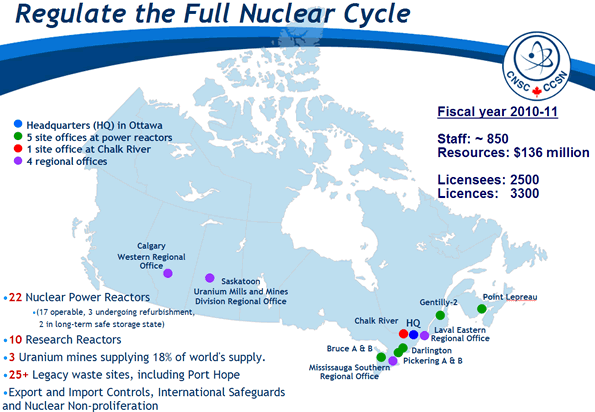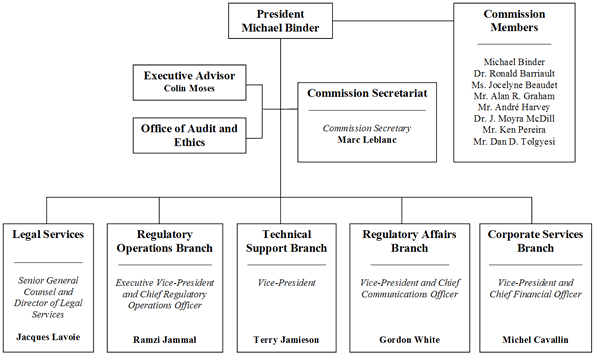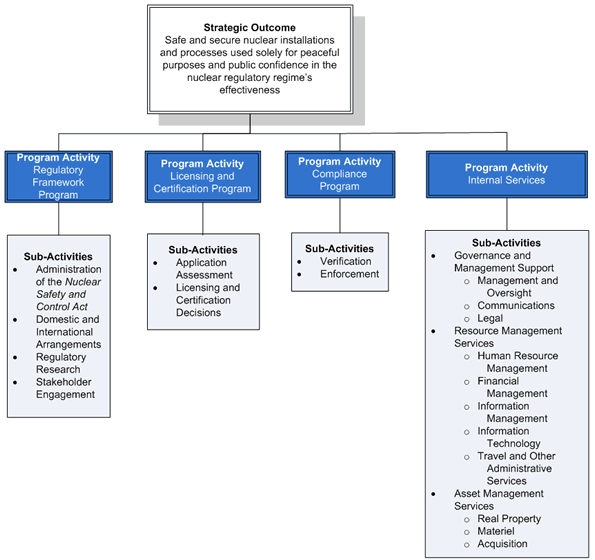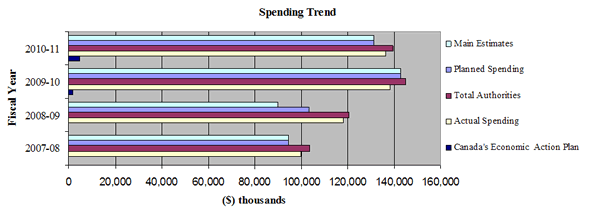Common menu bar links
Breadcrumb Trail
ARCHIVED - Canadian Nuclear Safety Commission - Report
 This page has been archived.
This page has been archived.
Archived Content
Information identified as archived on the Web is for reference, research or recordkeeping purposes. It has not been altered or updated after the date of archiving. Web pages that are archived on the Web are not subject to the Government of Canada Web Standards. As per the Communications Policy of the Government of Canada, you can request alternate formats on the "Contact Us" page.
Section I – CNSC Overview
Message from the President
As the Canadian Nuclear Safety Commission (CNSC) celebrates 65 years as Canada’s independent nuclear regulator, I am inspired to reflect on the many milestones we have achieved.
Canada’s nuclear activities have grown significantly since 1946 and, as a mature nuclear nation, we have much to be proud of: above all, steady progress over time toward a peaceful and productive nuclear regime, and a safety record second to none in the world.
Last year presented some unexpected challenges, during which our staff responded swiftly, effectively and with transparency. As examples, throughout the first month of the Japan crisis and the concurrent three-week-long Darlington Joint Review Panel (JRP) hearing, all of my colleagues at the CNSC worked tirelessly and often around the clock. Amid these challenges, our team of 850 dedicated employees embraced the CNSC’s role to protect the health, safety and security of people and the environment, and to implement Canada’s international obligations for the peaceful use of nuclear energy. Meanwhile, staff ensured the safe operation of all nuclear-related facilities and activities in Canada.
This performance report highlights just a few of our most important achievements. Above all, each and every one of our licensed facilities continues to operate safely and in compliance with our regulatory requirements. Some achievements included authorizing Atomic Energy of Canada Limited to resume medical isotope production at Chalk River after 15 months of repairs. We established the Participant Funding Program, which provides members of the public, Aboriginal groups and other stakeholders with financial assistance so they can participate in our regulatory decision-making process. We participated in the Darlington JRP, Canada’s first JRP for a new nuclear power plant.
The public is focused on the CNSC these days. Our ability to provide up-to-the-minute information to our stakeholders and federal colleagues has made us the go-to organization for information on nuclear activities and nuclear safety. More than that, our successes last year cemented the CNSC’s reputation as a world-class regulator. We are more respected than ever by our peers in government, our international counterparts and nuclear industry stakeholders.
Even as we reflect on our history and achievements, we are determined to meet the regulatory challenges of the future. As Canada’s nuclear industry evolves, we will continue to evolve alongside it. And our core commitment to Canadians will not change: we will never compromise safety.
Original signed by
Michael Binder
President
Organizational Overview
Raison d’�tre and responsibilities
In 1946, the Canadian Parliament passed the Atomic Energy Control Act and established the Atomic Energy Control Board (AECB), providing it with the power to regulate all nuclear activities related to the development and use of atomic energy in Canada.
More than half a century later, in May 2000, the Nuclear Safety and Control Act(NSCA) came into effect and established the Canadian Nuclear Safety Commission (CNSC) as the successor to the AECB, with the authority and responsibilities to regulate an industry that spans all segments of the nuclear fuel cycle and a wide range of industrial, medical and academic uses of nuclear substances.
The CNSC is an independent regulatory agency and quasi-judicial administrative tribunal, with jurisdiction over all nuclear-related activities and substances in Canada.
Vision
To be the best nuclear regulator in the world.
Mission
Regulating nuclear activities to protect the health, safety and security of Canadians and the environment, and to implement Canada’s international commitments on the peaceful use of nuclear energy.
Mandate
Under the NSCA, the CNSC achieves its mission by:
- regulating the development, production, possession, transportation and use of nuclear energy and substances in Canada
- implementing measures to meet international and domestic controls on the non-proliferation of nuclear weapons and nuclear explosive devices
- providing objective scientific, technical and regulatory information about the activities of the CNSC
In this context, the CNSC:
- is also responsible for implementing the Government of Canada’s December 2007 Directive to the Canadian Nuclear Safety Commission Regarding the Health of Canadians, which requires the CNSC – when regulating the production, possession and use of nuclear substances – to consider the health of those Canadians who, for medical purposes, depend on nuclear substances produced by nuclear reactors
- as a Responsible Authority under the Canadian Environmental Assessment Act (CEA Act), carries out environmental assessments (EAs) for nuclear projects in accordance with this legislation
- administers the Nuclear Liability Act and is Canada’s authority with respect to the implementation of nuclear safeguards as set out in the Agreement Between the Government of Canada and the International Atomic Energy Agency for the Application of Safeguards in Connection with the Treaty on the Non-Proliferation of Nuclear Weapons
- administers the nuclear non-proliferation provisions of bilateral nuclear cooperation agreements that the Government of Canada enters into with foreign nuclear trade partners
The Commission Tribunal has up to seven permanent members, appointed by the Governor in Council, and is supported by employees across Canada. The CNSC President is the only full-time Commission Tribunal member, while other members may be appointed to serve on a full- or part-time basis. Temporary members can also be appointed by the Governor in Council, as required. Commission Tribunal members are chosen according to their credentials and are independent of any political, governmental, special interest group or industry influences.
As a quasi-judicial administrative tribunal and court of record, the Commission Tribunal makes independent, fair and transparent decisions on the licensing of nuclear-related activities, establishes legally binding regulations, and sets regulatory policy direction on matters relating to health, safety, nuclear security and the environment. For licensing matters related to major nuclear facilities, the Commission Tribunal considers applicant proposals, recommendations of CNSC staff, and stakeholder views before making decisions. In order to promote openness and transparency, the Commission Tribunal conducts its business to the greatest extent possible in public hearings and meetings and, where appropriate, in communities affected by the decision at hand. Commission Tribunal hearings are conducted in a public forum approximately 10 times per year, and decisions are usually released within 30 business days after the closing of the hearings.

You can view maps showing the location of CNSC-regulated facilities on our Web site.
The following organizational chart provides additional details about the CNSC:

Strategic Outcome and Program Activity Architecture
The following diagram illustrates the CNSC’s framework of program activities and program sub-activities, which support its strategic outcome:

Organizational Priorities
The CNSC undertakes work in support of its single strategic outcome. For 2010–11, the CNSC focused its efforts on the following priorities.
- Performed licensing and compliance regulatory oversight for over 2,500 licensees and 3,300 licences across Canada’s nuclear sector
- Conducted public hearings for the renewal of licences for Pickering A, Gentilly-2, and Point Lepreau
- Provided pre-licensing reviews for vendors’ designs of new nuclear power plants
- Performed regulatory oversight of nuclear power plant refurbishment
- Reviewed the Environmental Assessment Screening Report for the re-licensing of the NRU isotope production and research reactor at Atomic Energy of Canada Limited’s Chalk River Laboratories
- Ensured implementation of the approach to environmental assessment as announced in Budget 2010
- Streamlined the licensing process for nuclear power plants
- Strengthened technical assessments and inspection procedures to ensure a consistent approach to the evaluation and inspection of all nuclear facilities and activities
- Developed the CNSC-wide Action Tracking System
- Completed improvements in the Regulatory Framework Program and governance
- Completed the design of the Participant Funding Program as announced in Budget 2010
- Strengthened the CNSC’s Research and Evaluation functions
- Focused on becoming an employer of choice
- Continued to enhance internal and external communications
In completing these priorities, the CNSC also maintained its focus on its key ways of doing business: the Core + 4 Cs. In particular, the CNSC focused on its core work of licensing and compliance, and undertook specific initiatives presented in “Section II – Analysis of Program Activities by Strategic Outcome”.
A brief summary of the “4 Cs” follows:
Commitment to ongoing improvements – “Always room for improvement”
This priority area includes completing initiatives under the Harmonized Plan, a set of internal improvements that respond to recommendations from past audits, lessons learned and peer reviews such as the International Atomic Energy Agency’s (IAEA) Integrated Regulatory Review Service (IRRS). It also includes ensuring that the health of Canadians and the safety of facilities are central considerations in all licensing and compliance activities through initiatives such as isotope contingency planning and the assessment of environmental concerns. This priority, as well, encompasses improvements in corporate services and policies, including those identified through various audits.
Summary of 2010–11 achievements within this priority area:
- Under the umbrella of the Harmonized Plan, the CNSC has completed 26 of the 32 initiatives recommended by the IAEA’s IRRS mission in 2009. The remaining six initiatives will be completed in 2011–12.
- CNSC staff also streamlined its licensing process for nuclear power plants by standardizing power reactor operating licences (PROLs) and introducing the Licence Conditions Handbook (LCH). The LCH clearly and transparently sets out the compliance verification criteria as well as any CNSC recommendations or guidance for the licensee.
- The CNSC announced its decision to authorize Atomic Energy of Canada Limited (AECL) to resume medical isotope production at Chalk River after 15 months of repairs to the National Research Universal (NRU) reactor. A few months later, the CNSC completed a peer-review workshop on AECL’s integrated safety review of the NRU – a form of additional verification, given the complexity of the original work – which concluded that the CNSC staff had identified all of the major issues in the NRU review. This was the first time that a licensee was invited to observe the CNSC internal peer-review process.
Clarity of our requirements – “So everyone understands the rules”
This priority area centres on creating broad awareness among licensees, vendors of nuclear technology and proponents of the CNSC’s requirements stemming from the NSCA, whether for renewals, refurbishments and life extensions, or new projects (such as design reviews, Joint Review Panels (JRPs), etc.). Its other goals are revitalizing the CNSC’s regulatory framework; developing and updating regulatory documents and guidance, with particular attention to guidance for licence applications and environmental assessments; engaging government partners through the Major Projects Management Office (MPMO); and continuing the implementation of the protocol for NRU licence renewal. More information about the MPMO is available on its Web site.
Summary of 2010–11 achievements within this priority area:
- The CNSC hosted or co-hosted various workshops on subjects such as small-scale nuclear reactors and aging management. In one instance, it held its largest-ever Webinar workshop for the public and environmental non-governmental organizations (ENGOs). Fifty participants were at the seminar, with representation from ENGOs, the general public, industry as well as an international representative from the Indonesian nuclear regulator.
- The CNSC also consulted with the public and ENGOs during the development of regulatory documents.
Capacity for action – “Ready to respond no matter what the situation”
This priority area focuses on ensuring the CNSC’s internal capacity (the right people, at the right time, doing the right things) to respond to changing events, all while fulfilling our mandate. Thus, the CNSC is continuing its efforts to establish itself as a recognized employer of choice, maintaining a sustainable financial management and internal control framework, strengthening planning, and focusing on information management progress in key areas such as compliance reporting, inspection tracking/resolution and financial management.
Summary of 2010–11 achievements within this priority area:
- In an effort to consolidate regulatory information on action tracking at the CNSC into a single, authoritative source, efforts continued towards the deployment of a CNSC-wide Action Tracking System. This system streamlines the collection and results of the monitoring of all activities associated with licensing, compliance, and regulatory commitments (e.g., inspection results, action items and safety performance assessments).
- The CNSC was recognized as one of the 2011 National Capital Region’s Top Employers.
- The CNSC completed the design and construction of a new laboratory infrastructure, allowing the CNSC to provide expert services and advice on instrument calibration and sample analysis to support CNSC licensing and compliance verification activities. These upgrades mean that the CNSC will be better positioned to meet public information obligations and to seek international standards accreditation.
- Manual financial transactions and processes were automated with the introduction of the CNSC Planning, Management and Reporting Systems (CPMRS), yielding greater accuracy and more robust and mature management of financial forecasting and budget management.
Communications – “Accurate, clear, concise and timely”
This priority area aims to strengthen communications with the CNSC’s licensees, Canadians, stakeholders, Aboriginal peoples, international counterparts, other government departments and central agencies, in accordance with the CNSC’s goal of being the best nuclear regulator in the world and its mandate to disseminate objective scientific, technical and regulatory information to the public about regulatory activities.
Summary of 2010–11 achievements within this priority area:
- The CNSC presented CNSC 101 sessions to provide a comprehensive introduction to the CNSC as a regulatory organization.
- Visitors to the CNSC’s Web site in 2010–11 increased by over 35% as a result of the Japan crisis and the Darlington JRP hearings, making the CNSC the go-to organization for Canadians for information on nuclear activities and nuclear safety.
- The CNSC developed an Educational Resources section on its external Web site, for students and educators from grades 2 to 12.
- To celebrate its 65th anniversary, the CNSC shared nuclear-related information via an interactive historical timeline, messages, staff anecdotes and a lobby exhibit.
Risk Analysis
Through its strategic planning exercise in the fall of 2009, the CNSC identified key risks that could impact its objectives for 2010–11. The following is a description of these risks along with the mitigation strategies put in place to address them.
Major project delays
Over the past few years, the CNSC developed and implemented an aggressive recruitment strategy, in anticipation of new major nuclear projects advancing in Canada. The CNSC adjusted its plans to respond to industry projections, including delays in the announcements of new nuclear power plants in Canada, as a result of the economic downturn. If such projects are further delayed or cancelled outright, cost recovery revenues could be significantly affected. The CNSC has initiated contingency plans to adapt to changes without compromising its capacity to meet its regulatory responsibilities.
Sunset funding
Activities of the CNSC that are exempt from fees or otherwise not cost recoverable, such as not-for-profit medical institutions (e.g., hospitals and cancer clinics), educational institutions (e.g., universities) and federal government departments, are covered by government appropriations. Incremental funding of $13.3 million provided in 2006 and 2008 to deal with necessary workloads expired at the end of FY 2010–11. The CNSC is working with the Government to ensure that it continues to resource the CNSC to fulfill its mandate.
Unforeseen demands
An additional challenge that the CNSC faced in 2010–11 was the unforeseen demands which included public concerns over the transport of the steam generators through the Great Lakes (the subject of public hearings in the fall of 2010) and the recent events in Japan, which drew significantly on CNSC resources that were otherwise allocated to planned regulatory activities. The CNSC responded by revising plans and reallocating resources to deal with these events while at the same time ensuring that regulatory oversight was not compromised.
Summary of Performance
2010-11 Financial Resources ($ thousands)
| Planned Spending | Total Authorities | Actual Spending |
|---|---|---|
| 131,422 | 139,638 | 136,239 |
The financial resources table above provides a summary of the total planned spending, total authorities and actual spending for the CNSC.
2010-11 Human Resources (FTEs)
| Planned | Actual | Difference |
|---|---|---|
| 850 | 847 | 3 |
The human resources table above provides a summary of the total planned and actual human resources for the CNSC.
Performance Summary by Program Activity ($ thousands)
| Program Activity | 2009-10 Actual Spending ($ thousands) |
2010-11 ($ thousands) | Alignment to Government of Canada Outcomes | |||
|---|---|---|---|---|---|---|
| Main Estimates |
Planned Spending |
Total Authorities |
Actual Spending |
|||
| Regulatory Framework | 24,345 | 19,407 | 19,407 | 20,859 | 21,309 | Social Affairs - Safe and Secure Canada |
| Licensing and Certification | 25,045 | 27,709 | 27,709 | 29,974 | 28,239 | |
| Compliance | 39,724 | 39,868 | 39,868 | 42,714 | 40,725 | |
| Internal Services | 49,238 | 44,438 | 44,438 | 46,091 | 45,966 | |
| Total | 138,352 | 131,422 | 131,422 | 139,638 | 136,239 | |
The previous table indicates that total authorities used between 2009–10 ($138.4 million) and 2010–11 ($136.2 million) have decreased by $2.2 million. The main reason for the decrease in expenditures is that the CNSC no longer administers the Technical Standards and Safety Authority (TSSA) on behalf of licensees.
Expenditure Profile – Funding of Operations
The CNSC is mainly funded from a revenue-spending authority (RSA) (approximately 70%) allowing the cost recovery of activities through fees collected from industry. This authority provides a sustainable and timely funding regime to address the rapid changes in the regulatory oversight workload associated with the Canadian nuclear industry.
The CNSC is also funded through an annual appropriation from Parliament for the remainder of its requirements. The regulations state that some licensees, such as hospitals and universities, are exempt from paying fees as these entities exist for the public good. In addition, fees are not charged for CNSC activities that do not provide a direct benefit to identifiable licensees. These include activities with respect to Canada’s international obligations (including the non-proliferation activities), public responsibilities such as emergency management and public information programs, and updating of the NSCA and associated regulations as appropriate.
In 2010–11, $136.2 million ($138.4 million in 2009–10) of the total parliamentary and revenue-spending authorities were used to fund the CNSC’s cost of operations, leaving $1.3 million ($4.8 million in 2009–10) in unused authority.
Cost of operations
In the 2010–11 financial statements, the total cost of operations was $146.9 million ($143.9 million in 2009–10). A total of $100.8 million ($97.4 million in 2009–10) in fees was recovered from fee-paying licensees, leaving the CNSC with a net cost of operations of $46.2 million ($46.5 million in 2009–10) to be funded by the annual parliamentary appropriations.

The figure above illustrates the CNSC’s spending trend from 2007–08 to 2010–11.
Canada’s Economic Action Plan (CEAP)
Through Budget 2009, $250 million was made available to departments and agencies over two fiscal years to upgrade deferred maintenance of federal laboratories. The focus was on laboratories that contribute to core regulatory responsibilities of the government, such as health and safety.
The CNSC was allocated a total of $3 million under Canada’s Economic Action Plan (CEAP) to upgrade its laboratory capabilities, bringing them up to international standards. In 2010–11, the design and construction of an upgraded laboratory infrastructure was completed and, consequently, the CNSC Laboratory moved from its former location at Tunney’s Pasture to the new location on Limebank Road. During the past year, the CNSC was also able to complete the upgrade with the purchase and installation of new equipment for instrument calibration and analytical services. In addition, the staff strength was augmented with three specialists.
The CNSC will seek laboratory accreditation in accordance with ISO-17025, complete the commissioning of newly purchased instruments, and finalize procurement of deferred equipment. The laboratory will continue to carry out instrument calibration in support of inspection activities, complete sampling for nuclear substances, support training at internal national and international levels, and conduct research and development activities in support of the CNSC research program. Nationally, the CNSC laboratory will be cooperating with the chemical, biological, radiological and nuclear (CBRN) Research and Technology Initiative (CRTI), universities, etc., and, internationally, with the Analytical Laboratories for the Measurement of Environmental Radioactivity (ALMERA) network of the IAEA.
Estimates by Vote
For information on the CNSC’s Votes and/or statutory expenditures, see the
2010–11 Public Accounts of Canada (Volume II) publication. An electronic version of the Public Accounts is available on the Public Works and Government Services Canada Web site.
